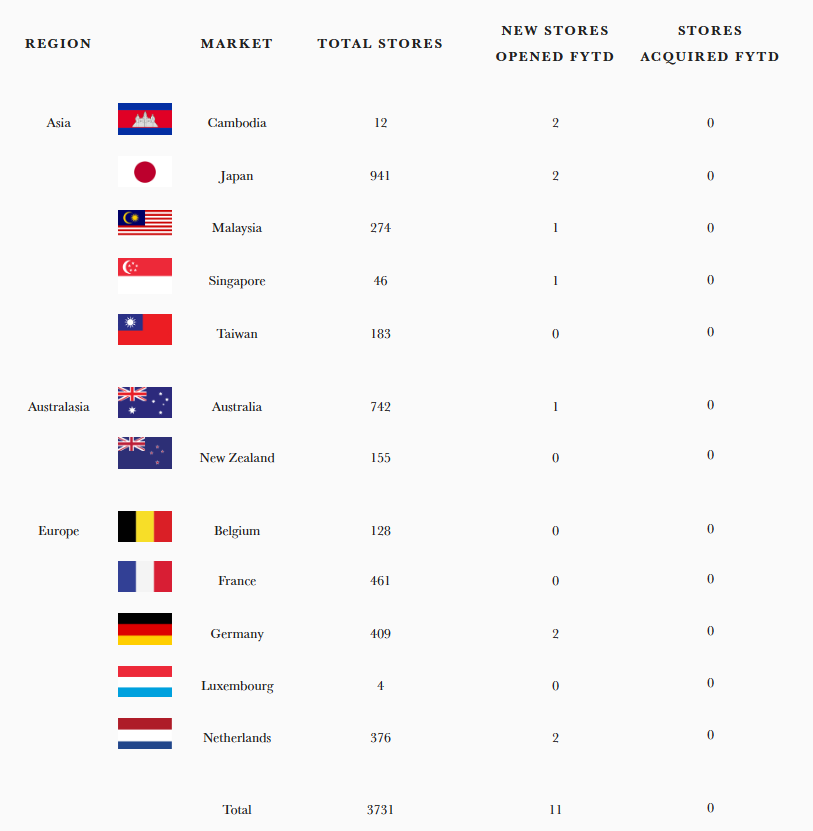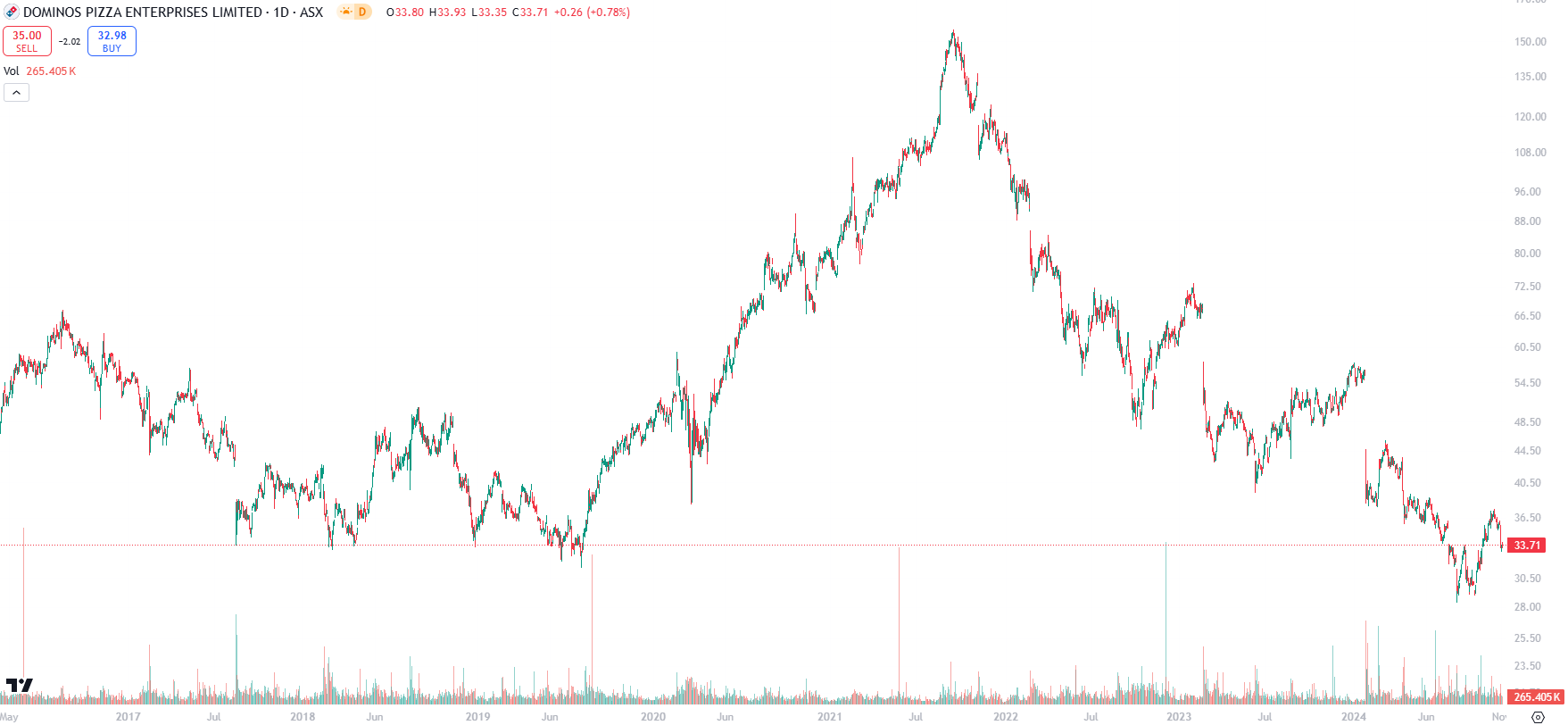Dominos Pizza Enterprises (ASX:DMP): Will it remain in the doldrums in FY25 as it transitions away from Don Meij?
![]() Nick Sundich, November 6, 2024
Nick Sundich, November 6, 2024
Dominos Pizza Enterprises (ASX:DMP) is stuck in a difficult position. Its share price is barely a quarter of its 2021 levels – how can this be when fast-food stocks are meant to be recession proof and immune to inflation? The company’s top line is proving reslient, but its bottom line…not so much.
To answer the question in this article’s title, FY25 could well be more of the same – even with the transition away from Don Meij’s leadership. And even when growth resumes, the glory days of FY20 and FY21 are unlikely to be coming back, and investors need to realise it. And we are sceptical of its expansion plans for Japan, or at least the idea that they will be successful.
Meet Dominos Pizza Enterprises
The Dominos Pizza Enterprises listed on the ASX is not the Domino’s parent company, but the master franchisor of Dominos in roughly a dozen countries: Australia, New Zealand, France, Germany, the Netherlands, Belgium, Luxembourg, Taiwan, Japan, Malaysia, Singapore and Cambodia. The irony is that this company services a population larger than the USA, with 418m people all up.
Dominos franchises its stores to franchisees who run the stores and pay the day-to-day costs. Dominos earns 7% of gross sales in royalties and a further percentage (of up to 6%) towards national advertising. Dominos pays a royalty to the parent company in the USA of 2-3% of sales, subject to market conditions.

Dominos Pizza Enterprises store count as at November 5, 2024 (Source: Company)
We have liked Dominos, and not just its pizzas
Our long-term readers would know we have a soft spot for this company. There are many things to like about it: Its long-term leadership, established market position in many jurisdictions, the propensity of fast food stocks generally to be good performers during tough economic times and the growth potential ahead of the company.
Dominos has a goal to have 7,100 stores by 2033, more than double the current number. Or at least, it did until mid-July when in a market update, the company admitted the goal was unlikely to be achieved. The bulk of this was expected come from Asia – particularly Japan. But the company has been through difficult times. It benefited during the pandemic as locked down consumers ordered pizza at home. The company was in perfect position to capitalise given its store network and in-house delivery system.
Inflation killed momentum
But as people remerged form their cocoons, inflation skyrocketed and Dominos saw sales flatline as people pivoted to cheaper options. High inflation on ingredients and unfavourable forex movements compounded the hit to the company’s bottom line. To say it has been an ugly couple of years for the share price is an understatement.

Dominos Pizza Enterprises (ASX:DMP) share price chart, log scale
DMP was not the only fast food stock to experience this. But its position as a ‘premium’ product meant it suffered more than peers, such as Collins Foods (ASX:CKF) that operates KFC outlets in Australia and Europe.
The pivot to value was not just seen amongst consumers, but investors too. Investors became weary of companies with big expansion plans and turned to value stocks. Dominos tried increasing prices, only to see demand fall and then sacrificing margins to maintain consumer demand.
In FY23, the company grew food sales by 2% (to $4bn), but its EBIT fell by 23% ($201.7m) and its pre-tax and post-tax profits fell by over 60% ($100.6m and $69m respectively). In FY24, sales increased nearly 5% to $4.2bn, and EBIT increased 3% to $207.7m. But…its underlying NPAT was down 8% to $120.4m, only a third of what it was in FY21 ($184m) and only a 5% margin on the basis of revenues versus an 8% margin in FY23.
The company hungs its hat on having higher sales, a store count and delivery count than 5 years ago – all by over 50%. Of course, this won’t remain true forever if growth lags. But even though the company is still seeing top-line growth, this came mostly from Europe and ANZ (Australia and New Zealand). Asian sales are retreating and European sales are flat. So while the company is not necessarily going backwards, it is not advancing.
A better future?
Dominos took some steps to turn things around. In June 2023, the company announced it would be exiting the loss-making Danish business and closing dozens of underperforming stores. Also in the first half of CY23, it unveiled new products and ‘value options’. In particular, it launched the My Domino’s Box that offers a pizza and 2 sides for A$10 each. And after such a long time of resisting partnering with third party delivery apps, head office decided to give in and embrace them.
A key pillar in the Dominos’ growth thesis is growth in delivery meals as well as standing out not just in pizza but in fast-food generally. Acknowledging the low margins, it thinks it can profit by having drivers improve delivery times and issue more pizzas. Of course there is reason to deliver faster, because product quality suffers. But investors would rather make more money from less people than less money from more people. Not literally, but in the sense of serving more customers but making less from each of them. Looking at the fast-food market, Dominos easily has a large share in pizzas, but fast-food is a much more competitive market with no shortage of companies with growth ambitions.
Dominos claims the opportunity exists. It has admitted there is little more room to grow in Australia and New Zealand, although it may need to make an effort into defending its share, because rival Pizza Hut has big plans to expand into Australia following its take over from Californian company Flynn Restaurant Group. Dominos asserting the chance exists in Europe and Asia, continuing to stand by its 7,100 store target by 2033 until today, but not admitting it was unlikely to be achieved.
In Japan, the company opened over 400 stores from FY20 to FY23, a 67% expansion pre- and post-COVID. Some of these stores have not proven viable, and the company has proposed to close up to 80 low volume stores, while opening 20+ new stores in higher potential locations. The company expects to return to positive Same Store Sales in Japan in FY25, and while admitting there would be some one-off investments to mitigate any increase, it expects margin improvements.
What about Europe and Japan?
In Germany and France, the company claims that 70% of the country remains uncovered and there is more room for growth. 2,900 of its 7,100 store count lies in Europe, and even this would mean it not reaching Australian levels of penetration. And it is claiming progress has been made in winning customers back since launching automated re-engagement campaigns. This can be accepted, along with assertions that Europeans do consume pizza.
But we are less confident about Japan. It is an extremely competitive market, including amongst pizza. The weak Japanese yen is making troubles in other markets (particularly input prices) more vehement than would otherwise be the case. Despite having 1,000 stores and not having the market perform, it still wants to double it to 2,000 by 2033.
No one can deny the company has a higher store count than it did 5 years ago. But is the roll out sustainable given how the market has been lagging Australia and Europe? Dominos isn’t denying the issues, but is claiming they are short-term. Only time will tell, but the longer the issues persist, it is difficult to claim the issues are short-term. But even if we are wrong in our scepticism of Japan, and all the company has to do is roll out stores and customers will come…it appears to be behind in its store roll out target (Goldman Sachs estimated it will miss 7-9%).
Don Meij on the way out
For over 20 years, the company has been led by Don Meij who started from the bottom as a deliverer for Silvio’s Dial-a-Pizza, and within 6 years becoming an operational executive. When Silivos bought Dominos in 1993, Meij became General Manager but continued to work on the front line, becoming a franchisee in 1996. In 2001, he and another franchisee merged their stores into the Dominos corporate store network in return for a 20% stake in the company. He became CEO in 2002 and the growth continued, doubling sales between then and its 2005 IPO.
Overall Meij had a great tenure, growing sales from $120m in 2001 to $4bn today. However, no CEO stays in place forever, and the longer they stay, the easier it is to say that a stagnating company can change as soon as its boss departs. Meij began to come under criticism as sales stagnated post-COVID. Scruitany around some of his property transactions (or a lack thereof) added up too. There were also eyebrows raised when his sister Kerri Hayman became ANZ head for the brain. To be fair, she had a Dominos career in her own right, including as operations director in the UK and a franchisee in the US.
In November 2024, one day before its AGM, DMP announced Meij would be succeeded by Mark van Dyck, a one time executive of food services company Compass Group. As he is an outsider, you have to imagine this was planned behind the scenes for some weeks, and indeed the company told investors there had been a global search. He will be paid $1.585m per annum including super, and will work with Meij over the next 12 months as part of a handover period.
At the same time, Dominos gave a trading update for FY25, noting Same Store Sales were down 1.2% vs 2.7% growth 12 months ago. It told investors German, French and Japan sales were down, but Taiwan, Singapore and Australia were among the good markets.
What is next?
Dominos has not given specific revenue or earnings guidance for the future, although it has advised store openings guidance. In FY25, it expects ~3% of the network, followed by 3-4% in FY26. Dominos’ long-term aim has been 7-9% store openings, but has told investors the timeline for a return to this will depend on improvements in franchise profitability. Again, it has admitted its 7,100 store goal is unlikely to be met in 2033, although has still said it believes this is appropriate.
‘Management is focused near-term on building franchise partner profitability and reducing average store payback, to facilitate higher, sustainable organic store growth to reach the long-term outlook,’ DMP told investors.
There are 15 analysts covering DMP and they expect a 12-month target price of $38.59, a decent premium of 15% to the current share price. This said, the current share price is 23.1x P/E for FY25 and a PEG of 1.8x.
Consensus estimates for FY25 expect $2.38bn in revenue and a $125m profit. Then in FY26, a $2.52bn revenue result and a $159m profit. In FY27, $2.7bn in revenue and a $188m profit. You can see things are gradually improving, but profitability will only reach pandemic levels in FY27.
Still upside, but a lot less than before
As with all stocks, it is hard to argue Dominos won’t create shareholder value if it can capitalise on its expansion plans successfully. But of course, as with all stocks, it is a big if. To buy a company is to take a gamble that it will all go well. For our part, we would like to see more evidence the company is turning around before taking the plunge – preferably in either a set of half-yearly or yearly results.
And of course, investors need to realise that the days of the pandemic, with high-margins and people stuck at home eating pizzas are gone. The fast food sector is a fiercely competitive, low-margin business whatever companies may tell you otherwise. We think there are better opportunities for investors at this point in time.
What are the Best stocks to invest in right now?
Check our buy/sell stock tips
Blog Categories
Get Our Top 5 ASX Stocks for FY25
Recent Posts
Mark the Pitt Street Research Semiconductor Conference 2025 in your calendars!
The Pitt Street Research Semiconductor Conference 2025 is coming up! Pitt Street Research in partnership with Bell Potter are thrilled…
Here’s How to Use AI to Pick Stocks and Whether or Not It is a Good Strategy
As Artificial Intelligence (AI) becomes more widespread, investors are asking how to use AI to pick stocks. We will cover…
Appen shares have plunged 90% from their peak! Is there any end to the bloodbath in sight?
There are few ASX shares that have seen such a fall from grace as Appen shares since 2020. In those…



